2016 TOYOTA AURIS TOURING SPORTS parking brake
[x] Cancel search: parking brakePage 218 of 660
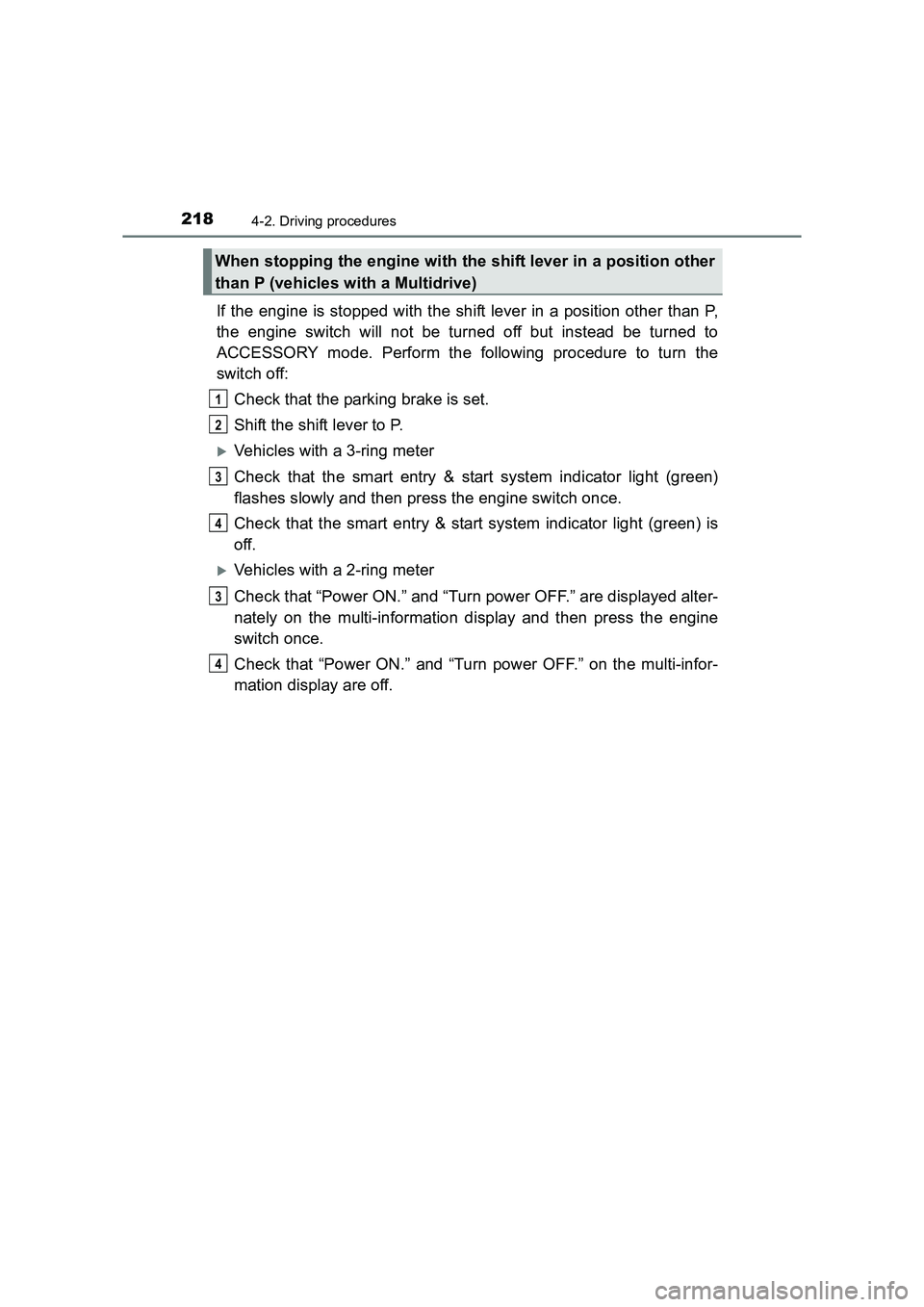
2184-2. Driving procedures
AURIS Touring Sports_EE (12K53E)
If the engine is stopped with the shift lever in a position other than P,
the engine switch will not be turned off but instead be turned to
ACCESSORY mode. Perform the following procedure to turn the
switch off:Check that the parking brake is set.
Shift the shift lever to P.
�XVehicles with a 3-ring meter
Check that the smart entry & start system indicator light (green)
flashes slowly and then press the engine switch once.
Check that the smart entry & start system indicator light (green) is
off.
�XVehicles with a 2-ring meter
Check that “Power ON.” and “Turn power OFF.” are displayed alter-
nately on the multi-information display and then press the engine
switch once.
Check that “Power ON.” and “Turn power OFF.” on the multi-infor-
mation display are off.
When stopping the engine with the shift lever in a position other
than P (vehicles with a Multidrive)
1
2
3
4
3
4
Page 232 of 660
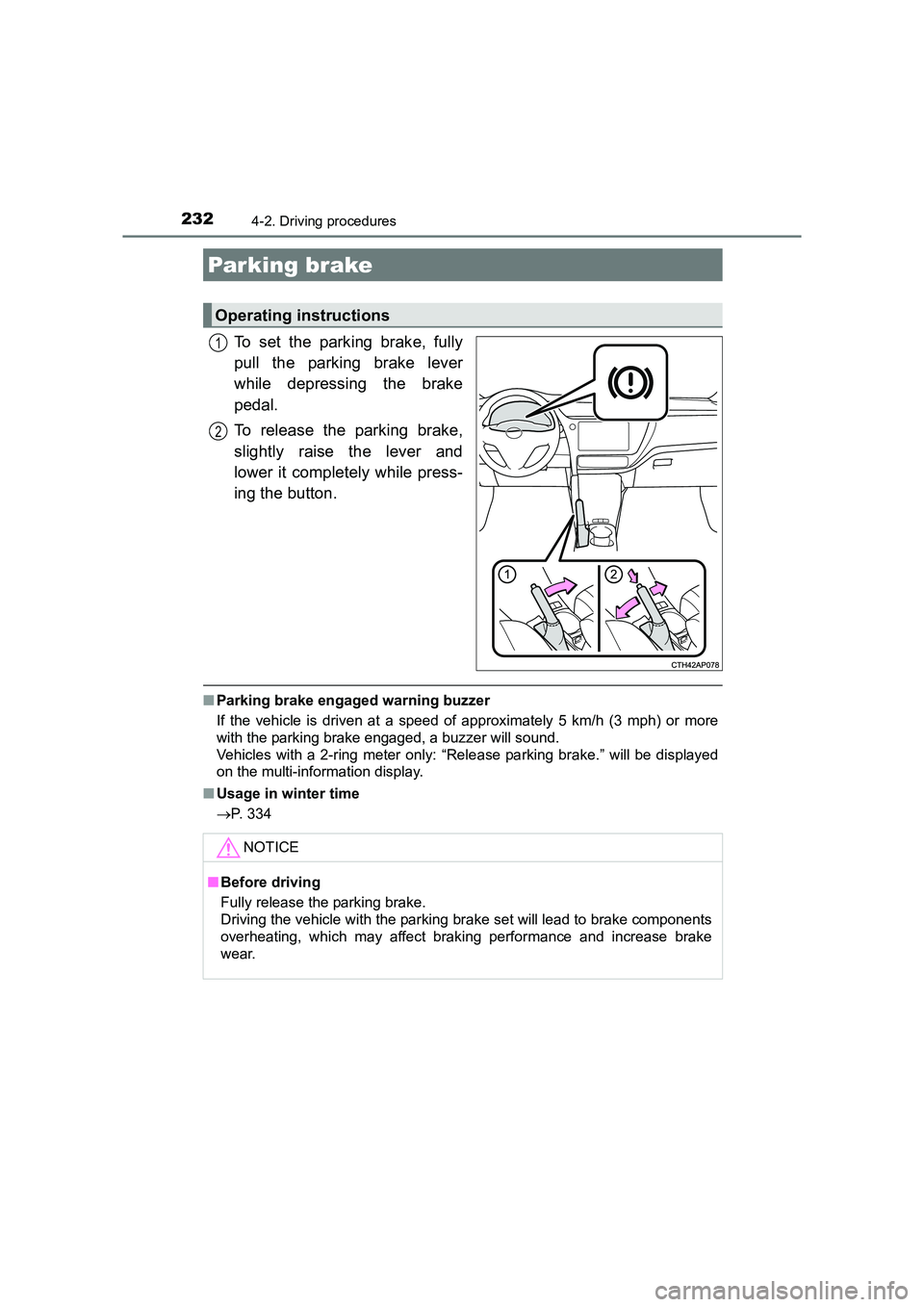
2324-2. Driving procedures
AURIS Touring Sports_EE (12K53E)
To set the parking brake, fully
pull the parking brake lever
while depressing the brake
pedal.
To release the parking brake,
slightly raise the lever and
lower it completely while press-
ing the button.
■Parking brake engaged warning buzzer
If the vehicle is driven at a speed of approximately 5 km/h (3 mph) or more
with the parking brake engaged, a buzzer will sound.
Vehicles with a 2-ring meter only: “Rel ease parking brake.” will be displayed
on the multi-information display.
■ Usage in winter time
→ P. 334
Parking brake
Operating instructions
1
2
NOTICE
■Before driving
Fully release the parking brake.
Driving the vehicle with the parking brake set will lead to brake components
overheating, which may affect braking performance and increase brake
wear.
Page 237 of 660
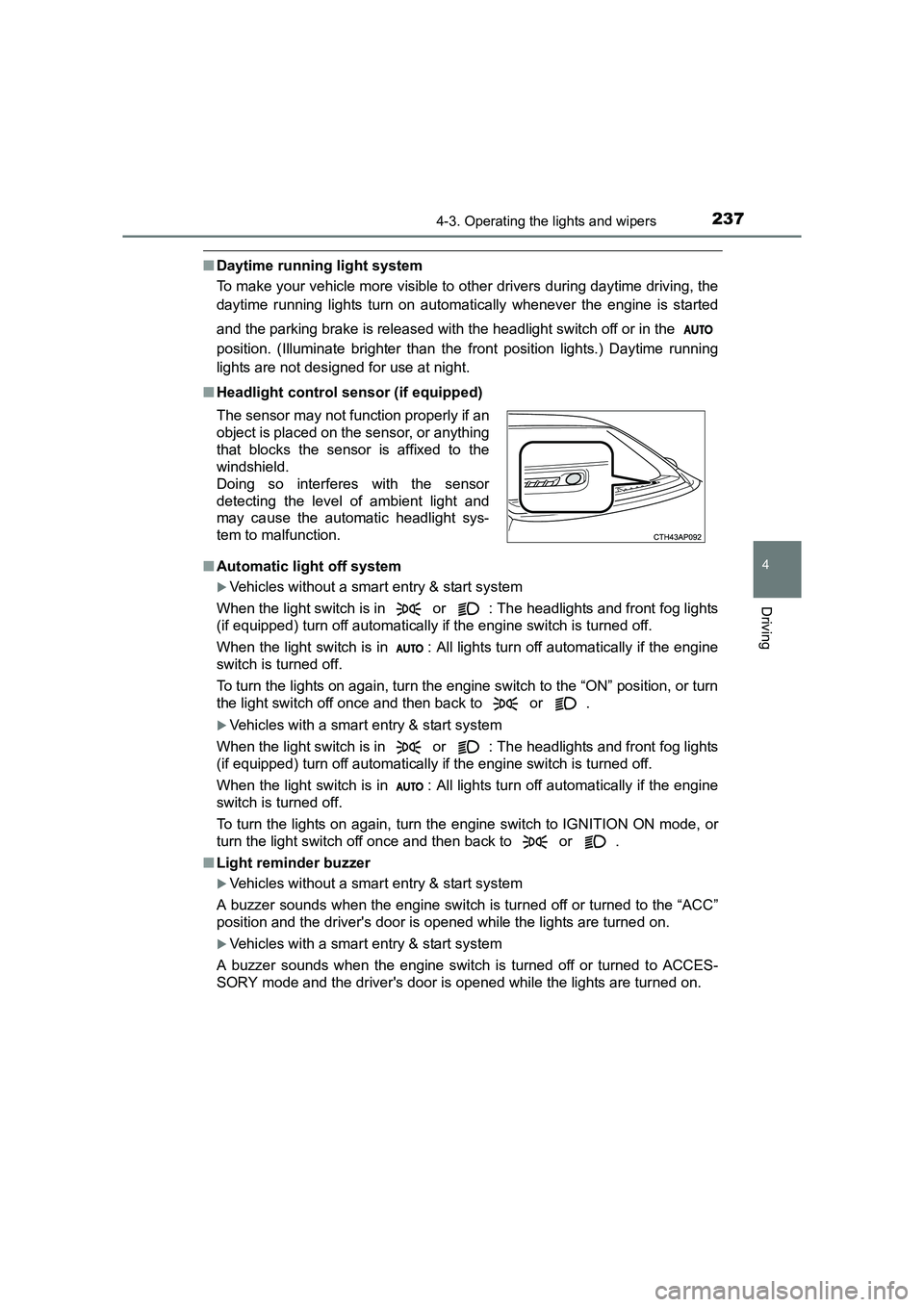
2374-3. Operating the lights and wipers
AURIS Touring Sports_EE (12K53E)
4
Driving
■Daytime running light system
To make your vehicle more visible to other drivers during daytime driving, the
daytime running lights turn on automatically whenever the engine is started
and the parking brake is released with the headlight switch off or in the
position. (Illuminate brighter than the front position lights.) Daytime running
lights are not designed for use at night.
■ Headlight control sensor (if equipped)
■ Automatic light off system
�XVehicles without a smart entry & start system
When the light switch is in or : The headlights and front fog lights
(if equipped) turn off automatically if the engine switch is turned off.
When the light switch is in : All lights turn off automatically if the engine
switch is turned off.
To turn the lights on again, turn the engine switch to the “ON” position, or turn
the light switch off once and then back to or .
�XVehicles with a smart entry & start system
When the light switch is in or : The headlights and front fog lights
(if equipped) turn off automatically if the engine switch is turned off.
When the light switch is in : All lights turn off automatically if the engine
switch is turned off.
To turn the lights on again, turn the engine switch to IGNITION ON mode, or
turn the light switch off once and then back to or .
■ Light reminder buzzer
�XVehicles without a smart entry & start system
A buzzer sounds when the engine switch is turned off or turned to the “ACC”
position and the driver's door is opened while the lights are turned on.
�XVehicles with a smart entry & start system
A buzzer sounds when the engine switch is turned off or turned to ACCES-
SORY mode and the driver's door is opened while the lights are turned on. The sensor may not function properly if an
object is placed on the sensor, or anything
that blocks the sensor is affixed to the
windshield.
Doing so interferes with the sensor
detecting the level of ambient light and
may cause the automatic headlight sys-
tem to malfunction.
Page 294 of 660
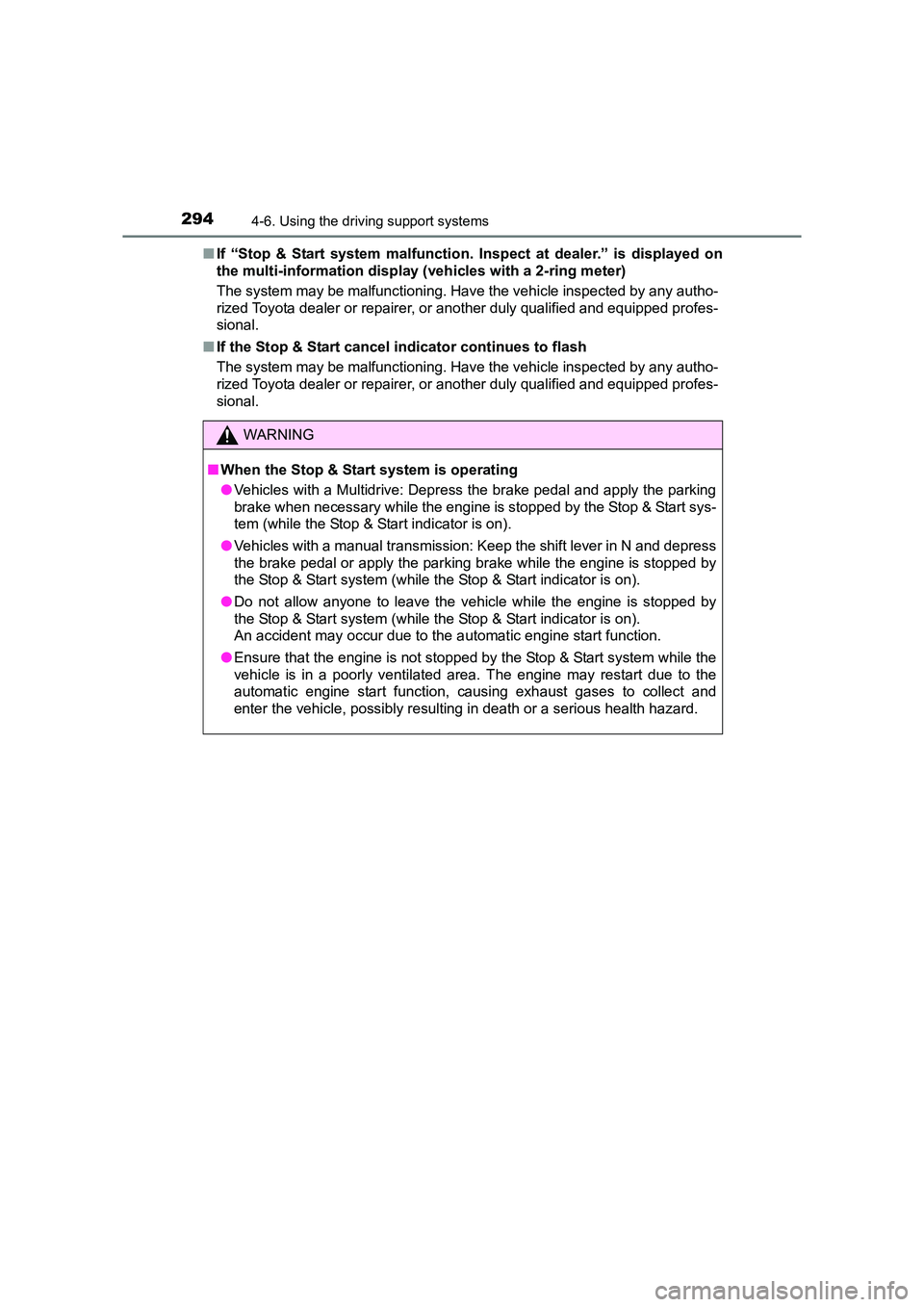
2944-6. Using the driving support systems
AURIS Touring Sports_EE (12K53E)■
If “Stop & Start system malfunction. Inspect at dealer.” is displayed on
the multi-information display ( vehicles with a 2-ring meter)
The system may be malfunctioning. Have the vehicle inspected by any autho-
rized Toyota dealer or repairer, or another duly qualified and equipped profes-
sional.
■ If the Stop & Start cancel indicator continues to flash
The system may be malfunctioning. Have the vehicle inspected by any autho-
rized Toyota dealer or repairer, or another duly qualified and equipped profes-
sional.
WARNING
■ When the Stop & Start system is operating
●Vehicles with a Multidrive: Depress the brake pedal and apply the parking
brake when necessary while the engine is stopped by the Stop & Start sys-
tem (while the Stop & Start indicator is on).
● Vehicles with a manual transmission: Keep the shift lever in N and depress
the brake pedal or apply the parking brake while the engine is stopped by
the Stop & Start system (while the Stop & Start indicator is on).
● Do not allow anyone to leave the vehicle while the engine is stopped by
the Stop & Start system (while the Stop & Start indicator is on).
An accident may occur due to the automatic engine start function.
● Ensure that the engine is not stopped by the Stop & Start system while the
vehicle is in a poorly ventilated area. The engine may restart due to the
automatic engine start function, causing exhaust gases to collect and
enter the vehicle, possibly resulting in death or a serious health hazard.
Page 310 of 660
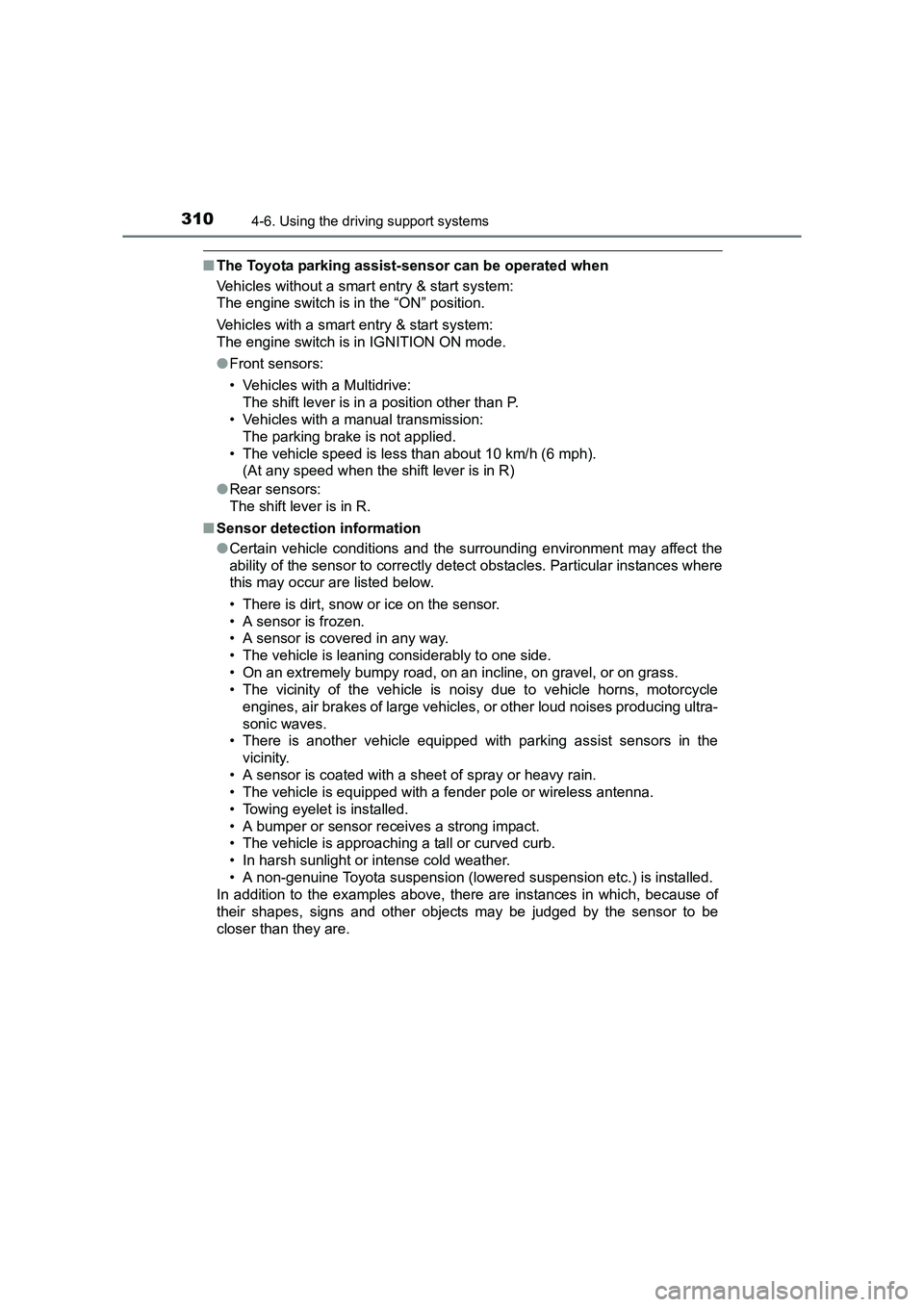
3104-6. Using the driving support systems
AURIS Touring Sports_EE (12K53E)
■The Toyota parking assist-sensor can be operated when
Vehicles without a smart entry & start system:
The engine switch is in the “ON” position.
Vehicles with a smart entry & start system:
The engine switch is in IGNITION ON mode.
●Front sensors:
• Vehicles with a Multidrive:
The shift lever is in a position other than P.
• Vehicles with a manual transmission:
The parking brake is not applied.
• The vehicle speed is less than about 10 km/h (6 mph). (At any speed when the shift lever is in R)
● Rear sensors:
The shift lever is in R.
■ Sensor detection information
●Certain vehicle conditions and the su rrounding environment may affect the
ability of the sensor to correctly detect obstacles. Particular instances where
this may occur are listed below.
• There is dirt, snow or ice on the sensor.
• A sensor is frozen.
• A sensor is covered in any way.
• The vehicle is leaning considerably to one side.
• On an extremely bumpy road, on an incline, on gravel, or on grass.
• The vicinity of the vehicle is noisy due to vehicle horns, motorcycle engines, air brakes of large vehicles, or other loud noises producing ultra-
sonic waves.
• There is another vehicle equipped with parking assist sensors in the
vicinity.
• A sensor is coated with a sheet of spray or heavy rain.
• The vehicle is equipped with a fender pole or wireless antenna.
• Towing eyelet is installed.
• A bumper or sensor receives a strong impact.
• The vehicle is approaching a tall or curved curb.
• In harsh sunlight or intense cold weather.
• A non-genuine Toyota suspension (lowered suspension etc.) is installed.
In addition to the examples above, there are instances in which, because of
their shapes, signs and other objects may be judged by the sensor to be
closer than they are.
Page 324 of 660
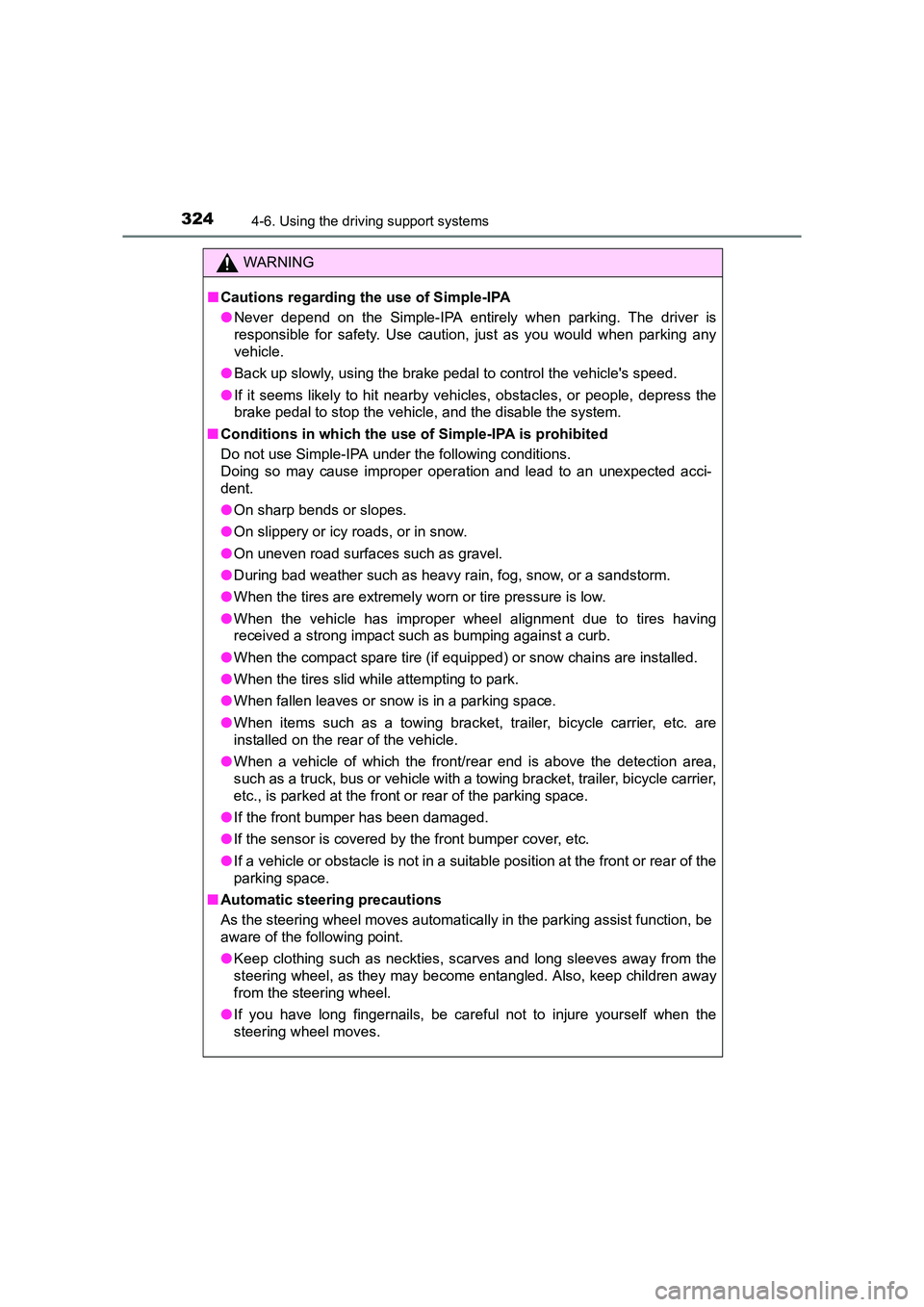
3244-6. Using the driving support systems
AURIS Touring Sports_EE (12K53E)
WARNING
■ Cautions regarding the use of Simple-IPA
●Never depend on the Simple-IPA entirely when parking. The driver is
responsible for safety. Use caution, just as you would when parking any
vehicle.
● Back up slowly, using the brake pedal to control the vehicle's speed.
● If it seems likely to hit nearby vehicles, obstacles, or people, depress the
brake pedal to stop the vehicle, and the disable the system.
■ Conditions in which the use of Simple-IPA is prohibited
Do not use Simple-IPA under the following conditions.
Doing so may cause improper operation and lead to an unexpected acci-
dent.
●On sharp bends or slopes.
● On slippery or icy roads, or in snow.
● On uneven road surfaces such as gravel.
● During bad weather such as heavy rain, fog, snow, or a sandstorm.
● When the tires are extremely worn or tire pressure is low.
● When the vehicle has improper wheel alignment due to tires having
received a strong impact such as bumping against a curb.
● When the compact spare tire (if equipped) or snow chains are installed.
● When the tires slid while attempting to park.
● When fallen leaves or snow is in a parking space.
● When items such as a towing bracket, trailer, bicycle carrier, etc. are
installed on the rear of the vehicle.
● When a vehicle of which the front/rear end is above the detection area,
such as a truck, bus or vehicle with a towing bracket, trailer, bicycle carrier,
etc., is parked at the front or rear of the parking space.
● If the front bumper has been damaged.
● If the sensor is covered by the front bumper cover, etc.
● If a vehicle or obstacle is not in a suit able position at the front or rear of the
parking space.
■ Automatic steering precautions
As the steering wheel moves automatically in the parking assist function, be
aware of the following point.
●Keep clothing such as neckties, scarves and long sleeves away from the
steering wheel, as they may become entangled. Also, keep children away
from the steering wheel.
● If you have long fingernails, be careful not to injure yourself when the
steering wheel moves.
Page 331 of 660
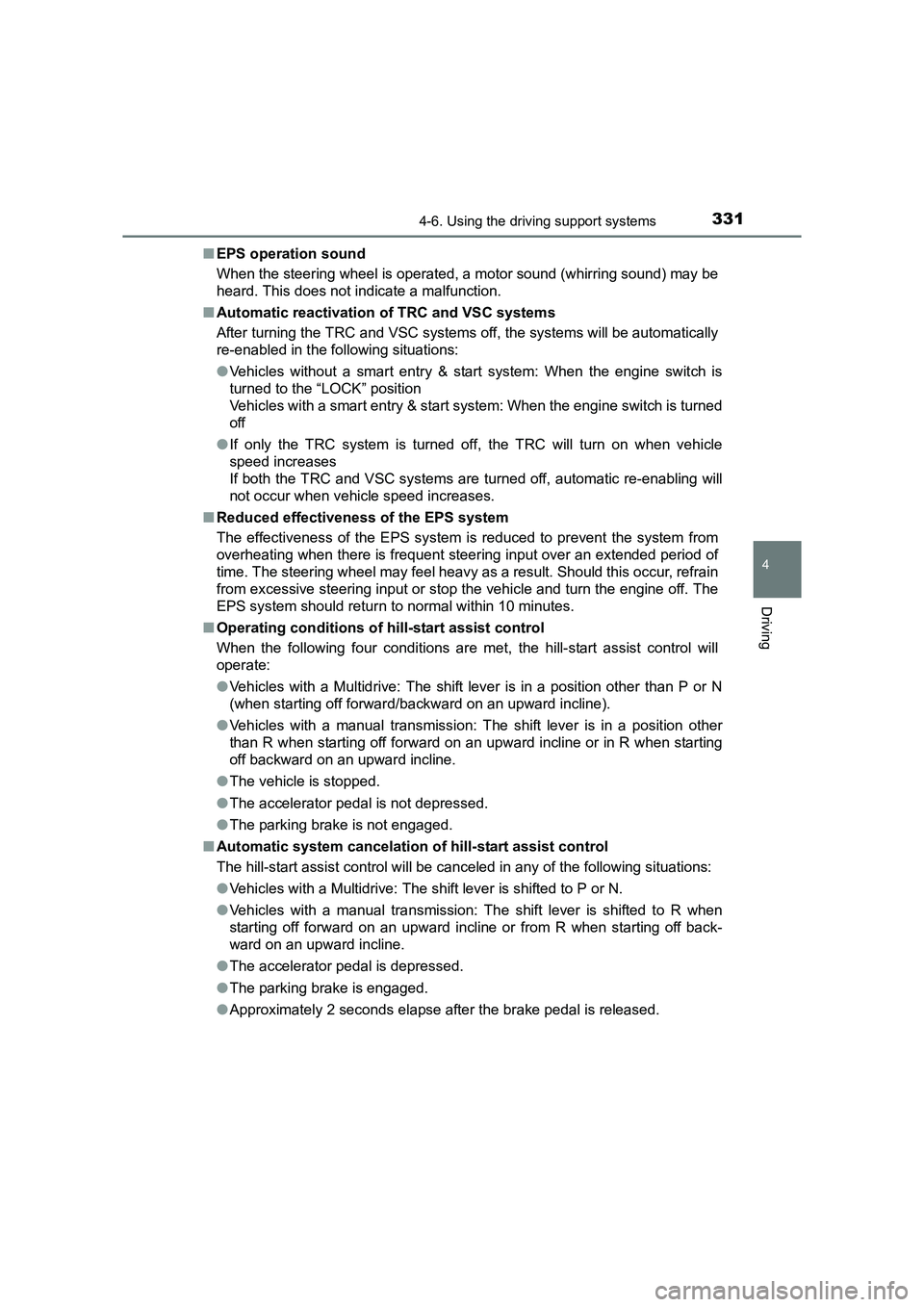
3314-6. Using the driving support systems
AURIS Touring Sports_EE (12K53E)
4
Driving
■EPS operation sound
When the steering wheel is operated, a motor sound (whirring sound) may be
heard. This does not indicate a malfunction.
■ Automatic reactivation of TRC and VSC systems
After turning the TRC and VSC systems off, the systems will be automatically
re-enabled in the following situations:
●Vehicles without a smart entry & start system: When the engine switch is
turned to the “LOCK” position
Vehicles with a smart entry & start system: When the engine switch is turned
off
● If only the TRC system is turned off, the TRC will turn on when vehicle
speed increases
If both the TRC and VSC systems are turned off, automatic re-enabling will
not occur when vehicle speed increases.
■ Reduced effectiveness of the EPS system
The effectiveness of the EPS system is reduced to prevent the system from
overheating when there is frequent steering input over an extended period of
time. The steering wheel may feel heavy as a result. Should this occur, refrain
from excessive steering input or stop the vehicle and turn the engine off. The
EPS system should return to normal within 10 minutes.
■ Operating conditions of hill-start assist control
When the following four conditions are met, the hill-start assist control will
operate:
●Vehicles with a Multidrive: The shift lever is in a position other than P or N
(when starting off forward/backward on an upward incline).
● Vehicles with a manual transmission: The shift lever is in a position other
than R when starting off forward on an upw ard incline or in R when starting
off backward on an upward incline.
● The vehicle is stopped.
● The accelerator pedal is not depressed.
● The parking brake is not engaged.
■ Automatic system cancelation of hill-start assist control
The hill-start assist control will be canceled in any of the following situations:
● Vehicles with a Multidrive: The shift lever is shifted to P or N.
● Vehicles with a manual transmission: The shift lever is shifted to R when
starting off forward on an upward incli ne or from R when starting off back-
ward on an upward incline.
● The accelerator pedal is depressed.
● The parking brake is engaged.
● Approximately 2 seconds elapse after the brake pedal is released.
Page 333 of 660

3334-6. Using the driving support systems
AURIS Touring Sports_EE (12K53E)
4
Driving
WARNING
■ Hill- start assist control does not operate effectively when
●Do not overly rely on hill-start assist control. Hill-start assist control may
not operate effectively on steep inclines and roads covered with ice.
● Unlike the parking brake, hill-start assist control is not intended to hold the
vehicle stationary for an extended period of time. Do not attempt to use
hill-start assist control to hold the vehicle on an incline, as doing so may
lead to an accident.
■ When the VSC is activated
The slip indicator light flashes. Always drive carefully. Reckless driving may
cause an accident. Exercise particular care when the indicator light flashes.
■ When the TRC/VSC systems are turned off
Be especially careful and drive at a speed appropriate to the road condi-
tions. As these are the systems to help ensure vehicle stability and driving
force, do not turn the TRC/VSC systems off unless necessary.
■ Replacing tires
Make sure that all tires are of the specified size, brand, tread pattern and
total load capacity. In addition, make sure that the tires are inflated to the
recommended tire inflation pressure level.
The ABS, TRC and VSC systems will not function correctly if different tires
are installed on the vehicle.
Contact any authorized Toyota dealer or repairer, or another duly qualified
and equipped professional for further in formation when replacing tires or
wheels.
■ Handling of tires and the suspension
Using tires with any kind of problem or modifying the suspension will affect
the driving assist systems, and may cause a system to malfunction.